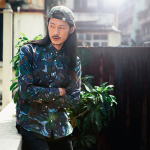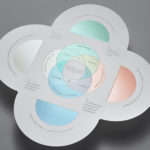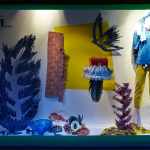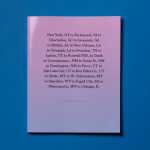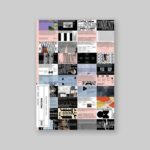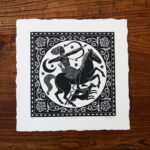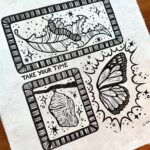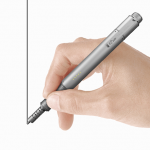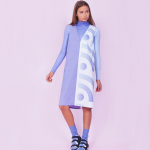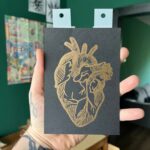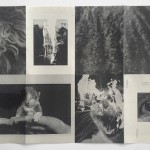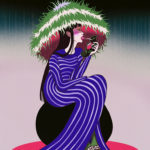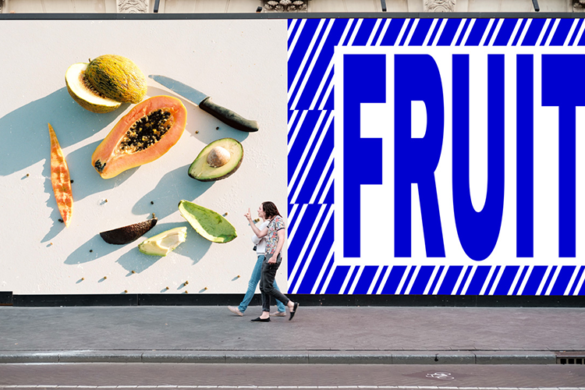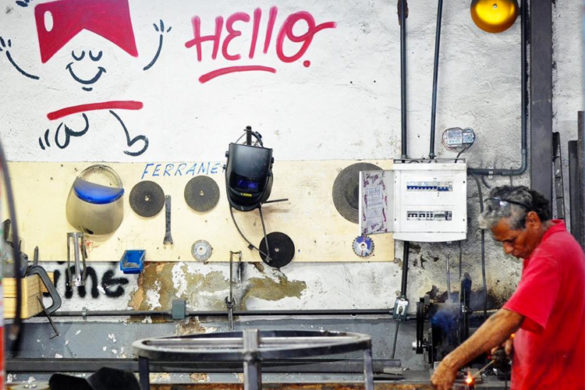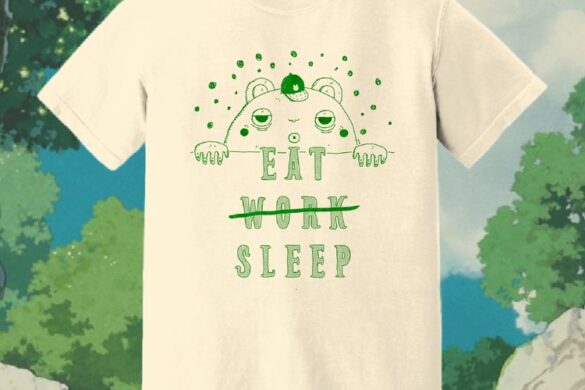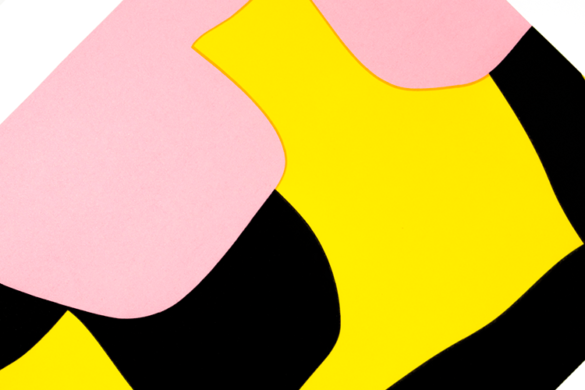We bloody love the guys down at Peckham Print Studio, so we went down for a chat over some tea and biscuits on their wonderful rooftop. Here is a little insight to the boys (Hugh and Nathan) who run this incredible new space in South London.
Photography and interview conducted by Miranda Foxx.
mirandafoxx@peopleofprint.com
Additional photographs by River Jade
river@peopleofprint.com
1. Tell us a little about your print history
H: You don’t have any!
N: *Laughs* My course fundamentally was based in screen printing as it’s main craft of producing. Surface design deals with the aesthetics of mainly textiles and paper that’s what 90% of people do there so screen printing is just a huge part of what that course is. I did take a bit of a break from it when I went to Copenhagen for a term, studying there I focused on just fine art and no print. When I got back I did a lot a structural stuff so I took a bit of a big break from it.
What was being taught at uni doesn’t relate to what is being done now. Hugh started a print project post-university which materialised and brought us into this Print Studio project.
H: My background mainly spawns from studying illustration at university and just falling in love with it relatively quickly in second year. I didn’t really manage to concentrate all my energies into experimenting with it as much as I felt I should have; which is a shame. By the time I was about to leave I had become addicted to screen printing,mainly because there are so many different printmaking techniques that you can explore, especially at LCC I felt it was important just to decide on one… and just went for it. Then worked really hard and cracked out as many hours as I could.
N: You were in there so much towards the end, literally you just lived in that studio.
H: Yeah it was the screen printing technician I learnt the most from in University. That was it really and I felt I had to dedicate to the cause. Then I did another seven months at a print studio in East London, there I learnt a lot of the business skills, the difference between an institution and their studio practice and then as a commercial studio and that approach, dealing with artists, dealing with quick turnovers. I delved heavily into inks and papers and just learnt really quickly and met a lot of incredible printmakers who I rate so so highly, I love them so much. Like Marco Laurence, incredible man and many more, seamlessly helping each other out and that’s why this endeavour is so important to us; the relationship printmakers have with other printmakers is something really quite special. We’re all trying to help each other out all the time and I love that.
N: It’s having this sort of venue, this entity we can use to help everyone out and get people involved is really important.
2. What made you want to set up a studio?
N: We had a print project going on and we were making posters on the floor of my other studio and that’s one thing, logistically how can we create all the art work for the project, then the next step is how do we print it and where do we print it. Because of the nature of the project it’s slightly frustrating, cos we have no where to crack on with it. Everybody already knows theres a shortage of places to print in London, it’s like a basic fact. Also theres that thing of wanting to solidify yourself and what you do within London and so needing an entity like this is so valuable. So when this all kicked off it seemed the most obvious thing, yeah definitely; of COURSE we’re going to do this. We were given the opportunity and there was no ifs or when, just now. It was literally no time between getting offered this and getting started it just snowballed really.
H: I think aswell for me it was seeing it being done somewhere else and not seeing it be done in a way I thought it was, theres so much aura around print studios and outside of University and quite frankly they’re not as epic as it seems and for me that was just such an eye-opener. For me it was quite clear what needs to happen; I want to carry on printing, do amazing work with other people and Nathan. We need to make something happen so that other people can embrace it the same way as we wanted to.
N: New things do have to kinda spawn up man, there are established print studios, especially in East and places like that but around here in the South there just isn’t anything like that.
3. Why choose Peckham to set up the studio?
N: To be honest, it wasn’t really like we said oh Peckham is going to be the next big thing, lets go there!. I think I knew it was going to be south, I already had a studio here, we both live in south so it was a natural thing to do really.
The reason why we’re actually here is because we got offered the space, there was a dialog between us and the guys that run the gallery, then they tweeted for screen printers to get in touch, a friend told me and it all went from there.
Getting offered a space here is just incredibly lucky. Just within arms reach you’ve got so many people that are just beavering away under the radar, it’s phenomenal the amount of work that’s getting created here. You may not hear about everything but then you get to meet so many people and you realise the amount of stuff that’s going on.
H: Even just looking at the south London art map, its just huge!
N: and theres so much more than that going on aswell.
H: We’re glad because theres a lot of galleries and a lot of that happening around but not so many places where you can technically produce things which I think is whats missing a bit. Now we’re here.
N: The thing is within the area theres a lot of entities to show work but theres a lack of places where you can produce and maybe show. And that sort of vessel where you can produce work and have an engagement with other people that are producing work. So you’re not just beavering away in your own studio but you have this real social place where theres a lot of people around. I said just yesterday that I love the fact that people can just pop in to talk to us, and that’s it. If they’ve got a query about printmaking they can just come in. That’s what we want the studio to be, just come in and pick our brains. More often than not, we learn so much from chatting to people. We had an hour long conversation about half tones. Its just nice to know that this can happen here.
4. Hows it been since opening compared to how you expected it to go?
N: I stupidly expected it to be really quiet, I somehow had this real misconception that we’d open and come in and do a couple of hours work and no one would come in but literally its just been non-stop, I don’t think we’ve done less than 12 hours a day most days. Not just like running the place, but the commercial work that comes through and we’ve got a handful of members already. Its really nice to know people have got faith in us. We’re new and haven’t established ourselves as much as other print studios and yet people have said we’ll give you our hard-earned money to come and use your facilities, trust that you can provide your service and we can produce professional work. It’s nice to know people can kind of trust us with that.
H: We worked hard, long and hard from the inception of the studio on just building up, on the PR on the marketing of the business and we didn’t skimp on anything. We realised once it had been set in motion we wanted to hit it really hard.
N: We got to pitch our idea to the guys in February and from there it was like… ok, go.
H: We did stupid things like, we had a 4-5 months projection and said we can get all the equipment in that time and looking back we were excruciatingly lucky. We outsourced all the equipment second hand and quite frankly, the way things dropped in on us and we just got it in and into the studio.
N: to hugh; You working at another studio gives you an idea of the basic need of a studio. If you’ve got that in mind then it how do you improve on that, you’ve got that as reference and its where do you go from there. We knew we wanted our studio to function differently from other studios so we knew we had to focus on those things.
5. If you could have any printmaker or designer in your studio who would it be?
N: Fuck that’s difficult.
H: That’s a really difficult question to answer!
N: It’d be too difficult to sit and think of the greatest greats, to be honest we were chatting with Heretic and they want to come down and I really want them to come work here. So at the moment that’s who I’d choose. Wait, and there’s a 13 year old kid from Manchester who’s set up his own print studio in his attic and he’s cracking out all these prints! We met him in East and were so dumbfounded that this kid’s just got on with it and built his own studio. I’d say that dude…I want him here. The unsung heroes of the print world!
H: I feel like I should be saying someone more glorious but quite frankly I’d like to do a project with Barbara; the print technician from LCC. Just straight up, professional to professional not in the institution anymore. She’s wonderful, she’s so good and its so difficult when you have to deal with like ten thousand students everyday! I used to go in an hour early everyday just so I could spend it talking to her. There was so much to talk about and then get working, I’d have failed my degree if I hadn’t made the time with such short deadlines.
N: When you’re given a question like that, with the big-boys that you are going to mention, you kind of know what they’re going to do but when its some dude who’s only just emerging, that seems so much more exciting.
H: We want to encourage more collaboration, not even with just printmakers but anyone, like people who build houses or furniture.
6. Who’s better at getting out of bed in the morning?
H: We both live really close. Which is important because it gives us that little bit of leeway.
N: Well we both have second jobs, so if I work til 1 or 2 in the morning, then Hugh gets in first. Or if he works late then I get in first.
7. What roles do you both play in terms of creativity and business?
N: Hugh is really good at getting biscuits *laughs*. We share a lot of stuff, there really isn’t a role, for instance when we started I handled a lot of accounting but when it came to booking stuff; Hugh did that. And really boring admin things we both did. With emails, it’s whoever gets it and responds first. Some days I’ll just be on emails and Hugh will be printing. We wanted to have that balanced approach, we both wanted to understand the way the business works in and out and we both have the same vision on how it should be run.
H: I think its lucky that I have a bit of experience on how a commercial print studio works, it was so minimal, but all of that I pulled straight into this, unadulterated. A pool of shared knowledge. And its not really been that taxing, the hardest thing we’ve found is it actually being a business, just like any small business. You start dealing with things like lots of monies and ins and outs and overheads, that’s been the most stressful part. You start developing it as we market it; as a print studio and getting in touch with artists that’s all so fun. Whatever comes along, we have a little chat about it, decide what steps we want to take and whoevers going to be appropriate for that.
8. We encountered your portable print bed a few months ago at the KKOutlet workshops but are there any plans to use it or progress it for the future?
H: Watch out for this one! We’re investing in a better bed at the moment. We originally got hold of a wooden one, added screen printing hinges and a Henry hoover for the suction bed.
N: It has to be a Henry.
H: That was just a means of taking a print bench to anywhere and start printing, I did a bit of that well before PPS. It’s so incredibly fun, the engagement with the community, people coming off the street not knowing anything about screen printing were able to just print there and then. We then developed it to two day projects where you could bring a design, we’d expose it over night and then could print the next day. So it started to become a little more personal. When PPS started we really hit it off and started to develop it a bit more and its been a great way of taking us out of this space and begin building a repertoire with this portable vessel.
N: It’s so simple that it doesn’t intimidate people, if they don’t know anything about printing they have the confidence to come up and ask what it is. They love it and respond to it so well. We’re investing in a sturdier bed at the moment and have some slightly bigger events in October and November. We just really want to cultivate this social printing, by doing these events that’s so many more people that come into contact with screen printing away from a studio.
H: I think the concept will never be any more sophisticated; it’ll always be dead basic.
N: The best thing is just isolating the printing, don’t bring anything else complicated into it.
9. Lastly, tell us about your biscuits…
H: Digestives on tap.
N: Every now and again there’s the Gingernut takeover. Which is good. But you know its just hard for me to like bring the biscuits. You are just so on it…
H: Although who brought the Vienettas downstairs??
Marcroy: *interrupts* I brought those!
H: I mean, Jesus! I’ve never seen a biscuit so intricate in my life!
We went to have a chat with the guys at Lovenskate at their studio before we set up ours, and I love that they have always put forward this unadulterated love for tea and biscuits. It’s always there, in every single thing they do, its always sitting there. We’re well on our way. We’ve got our own biscuit tin.
At this stage the conversation veers off onto the subject of biscuit saturation, sectioned tins and plant donations.
H: If we do a cheeky little exhibition in the future we’d love to get a bunch of illustrators to draw plants, then people bring a plant and take a plant print. We’ve talked about this a few times.
http://www.peckhamprintstudio.com

